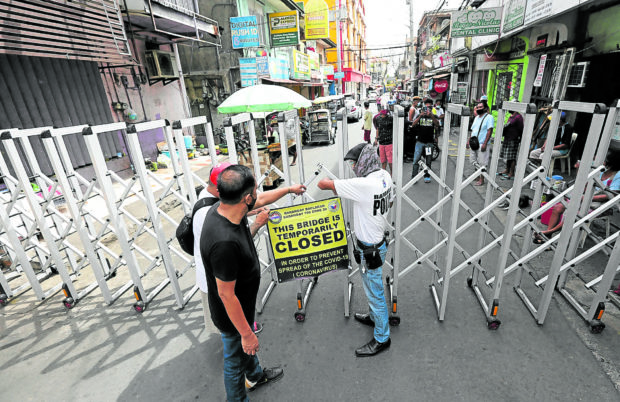
(FILE) LOCAL LOCKDOWN Village guards in Barangay Baclaran, Parañaque City, install an accordion-type barrier in March 2021, on a street that leads to a bridge that connects their city to Pasay City, where the more transmissible South African variant of the COVID-19 virus has been detected. The variant has also been detected in Parañaque, forcing the local lockdown. INQUIRER file photo / MARIANNE BERMUDEZ
MANILA, Philippines — Metro Manila and Calabarzon (Cavite, Laguna, Batangas, Rizal, and Quezon) have the highest number of cases of B.1.1.7 and B.1.351 variants of the SARS-CoV-2 virus in the country, the Department of Health (DOH) said Wednesday.
Health Undersecretary Maria Rosario Vergeire said Metro Manila has a total of 358 cases of the B.1.1.7 variant that was first detected in the United Kingdom, 602 cases of the B.1.351 first detected in South Africa, and 39 cases of the P.3 variant that was first reported in the Philippines.
Meanwhile, in Calabarzon, there are a total of 145 cases of the B.1.1.7, 121 cases of the B.1.351, and six cases of the P.3 variant.
“In NCR (National Capital Region) and Region 4A, nandito ‘yung bulk of cases for both South African and UK variants,” Vergeire said in an online press briefing.
(The bulk of cases for both South African and UK variants are in the NCR and Region 4A.)
As of May 3, the country has already recorded a total of 948 cases of the B.1.1.7 variant, 1,075 cases of the B.1.351, 157 cases of the P.3 variant, and two cases of the P.1 variant from Brazil.
But despite the increasing number of variant cases, Vergeire said the World Health Organization (WHO) still has yet to determine if there is already community transmission for these variants.
“We are only doing sampling. Ang sampling natin purposeful ‘yan (Our sampling is purposeful). Ibig sabihin (This means) we get samples from areas with clustering of infection, with linkages to specific individuals who turned positive for these variants,” said Vergeire.
“WHO, until now, cannot give that classification yet because they need further studies so that we can be able to determine if there is community transmission already for these variants,” she added.
The three variants of concern, such as the B.1.1.7, B.1.351, and the P.1 variant have been associated with higher transmissibility of the virus while initial studies also showed that the B.1.351 variant may have a potential impact on vaccine efficacy.
The Philippines currently has a total of 66,060 active COVID-19 cases as of Tuesday, including 5,683 additional cases.

